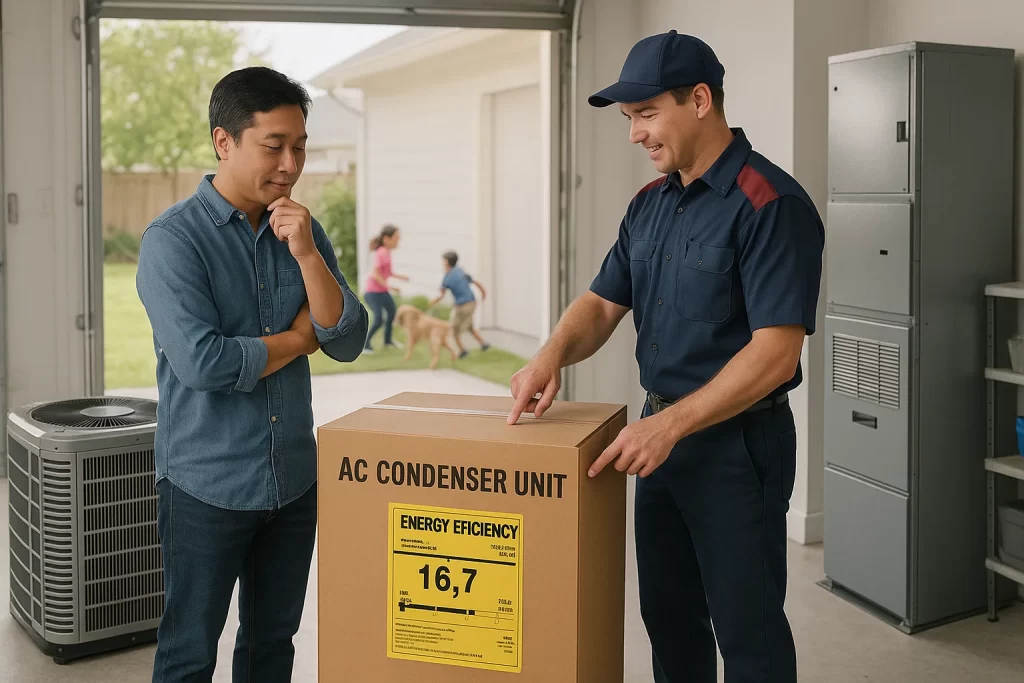Choosing a new air conditioning system isn’t just about staying cool—it’s about making a smart investment in your home’s comfort, energy efficiency, and long-term value. With so many options on the market, selecting the right AC can feel overwhelming. But don’t worry—this step-by-step guide will help you navigate your choices and make the best decision for your home’s AC installation in Columbia Falls, MT.
How Should I Approach AC Installation to Choose the Right Unit?
- Start with a precise load calculation to match system size with your home’s square footage, insulation, and window layout.
- Clarify your priorities: Consider energy efficiency, zoned cooling, quiet operation, or compatibility with future heating options.
- Compare system types: Central AC (if you have ducts), ductless mini-splits, or heat pumps, each fits different home layouts and comfort needs.
- Focus on efficiency ratings: Look for high SEER2 units to maximize long-term energy savings.
- Ensure professional installation: Proper duct sealing, refrigerant levels, and airflow balancing are essential for performance.
- Work with an HVAC expert to assess your home’s needs and guide product selection and installation.

Step 1: Measure Your Home for Optimal AC Sizing
The first and most crucial factor in selecting an air conditioner is determining the proper system size. A unit that’s too small won’t keep your home comfortable, while one that’s too large may cycle on and off frequently, reducing efficiency and lifespan. Professional HVAC technicians use calculations called “Manual J load calculations” to determine the correct system size based on your home’s square footage, insulation levels, window placement, and more.
Step 2: Identify Cooling Priorities and Room Needs
Are you replacing an older system? Expanding into a new area of the home? Looking for better energy efficiency or quieter performance? Identifying your cooling priorities—whether it’s lower energy bills, room-by-room control, or low maintenance—can help narrow your options. For example, ductless mini-splits are ideal for additions or areas without existing ductwork, while central AC systems work well for whole-home cooling.
Step 3: Compare AC System Types (Central, Ductless, etc.)
There are several types of air conditioners to consider:
- Central Air Conditioning: Best for homes with existing ductwork, offering even cooling and improved air filtration throughout the home.
- Ductless Mini-Split Systems: Ideal for older homes or room additions, offering individual zoning and high energy efficiency.
- Heat Pumps: These systems provide both cooling and heating, making them a versatile year-round solution.
Each option has pros and cons, and the best choice depends on your home’s structure and your comfort preferences.
Step 4: Review AC Energy Efficiency Ratings (SEER)
Efficiency matters—not just for your electric bill, but also for environmental impact. The SEER2 rating (Seasonal Energy Efficiency Ratio 2) indicates how efficiently an AC unit operates. The higher the SEER2 rating, the more efficient the unit. For Montana, the minimum SEER2 rating is 13.4, although they go even higher. While high-SEER models may have a higher upfront cost, they often pay off with energy savings over time.
Step 5: Factor in Installation Requirements and Costs
Proper installation is critical to performance and efficiency. Factors like duct sealing, thermostat placement, and airflow balancing can significantly affect how well your new AC works. Even the best unit can underperform if installed poorly.
Step 6: Get Professional HVAC Advice Before Buying
Choosing and installing the right AC system is not a DIY project. A qualified HVAC technician can assess your home, explain your options, and ensure everything is installed correctly for maximum performance. At every step—from system selection to installation—our team is ready to guide you.
Ready to Get Started?
Whether you’re upgrading your old system or outfitting a new space, we’re here to help. Contact our team today to schedule a free consultation. We’ll help you find the perfect cooling solution for your home, your budget, and your comfort.
Frequently Asked Questions
Question: What size of air conditioner do I need for my home?
Answer: You need an AC that matches your home’s cooling load. That means calculating required BTUs based on square footage, ceiling height, insulation, windows, and occupancy. A manual J load calculation by a professional ensures accurate sizing for efficiency and comfort.
Question: How important is energy efficiency when choosing an air conditioner?
Answer: Very. Higher SEER or SEER2 ratings mean lower energy consumption and cost. While high-efficiency units cost more upfront, they often pay for themselves through lower bills, rebates, and improved long-term value.
Question: Which type of AC system should I choose for my home?
Answer: It depends on your layout and needs. Window or portable units suit single rooms. Ductless mini‑splits are great for homes without ducts or for zoned cooling. Central air works best if you have existing ductwork and want whole‑home cooling.
Question: What features should I look for in a modern air conditioner?
Answer: Smart thermostats, programmable scheduling, dehumidifier or air‑purifier options, and noise‑reduction features can enhance comfort, convenience, and indoor air quality. These features can result in energy savings and improved living conditions.
Question: Do I need a professional installer, or can I install the system myself?
Answer: For window and some portable units, DIY is possible. But for ductless, mini‑split, central systems, or heat pumps, professional installation ensures proper sizing, airflow, refrigerant charging, and optimal performance, and it helps maintain your warranty.


